Click on images to enlarge
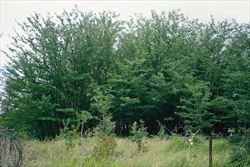
infestation (Photo: Land Protection, QDNRW)

habit (Photo: Sheldon Navie)
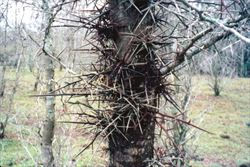
trunk with large branched thorns (Photo: Land Protection, QDNRW)
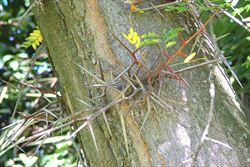
close-up of branched spines (Photo: Sheldon Navie)
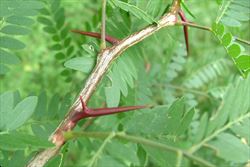
younger branch with developing spines (Photo: Sheldon Navie)
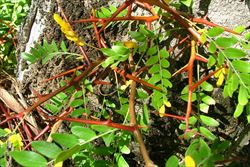
once-compound leaves amongst spines (Photo: Sheldon Navie)
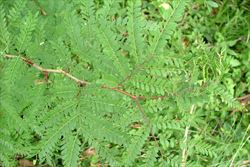
twice-compound leaves (Photo: Sheldon Navie)
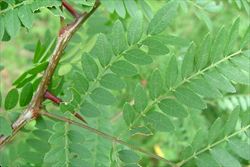
close-up of leaflets showing the finely toothed margins (Photo: Sheldon Navie)
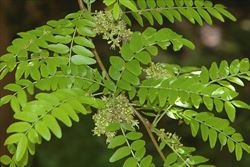
male flower clusters (Photo: Rob and Fiona Richardson)
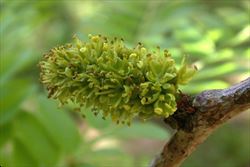
close-up of male flowers (Photo: Rob and Fiona Richardson)
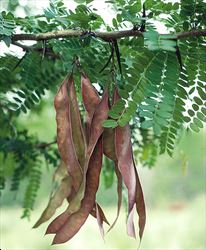
fruit (Photo: Land Protection, QDNRW)

close-up of seeds (Photo: Steve Hurst at USDA PLANTS Database)
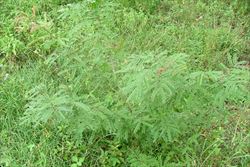
young plant (Photo: Sheldon Navie)
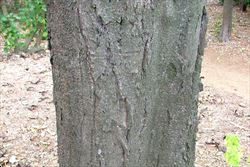
the thornless trunk of Gleditsia triacanthos forma inermis (Photo: Sheldon Navie)
Scientific Name
Gleditsia triacanthos L.
The thornless form of this species is known by the following scientific name:
Gleditsia triacanthos L. forma inermis (L.) C.K. Schneid.
Synonyms
The following are synonyms for the thornless form of the species:
Gleditsia inermis L.Gleditsia triacanthos L. var. inermis (L.) C.K. Schneid.
Family
Caesalpiniaceae (Queensland, the ACT, Victoria, Tasmania, Western Australia and the Northern Territory) Fabaceae: sub-family Caesalpinioideae (New South Wales)Leguminosae (South Australia)
Common Names
bean tree, common honeylocust, honey locust, honey locust tree, honey-locust, honeylocust, honeyshuck, McConnel's curse, sweet locust, thorny honeylocust
Origin
Native to eastern North America (i.e. large parts of central and eastern USA and southern Ontario in Canada).
Cultivation
The typical form of this species has been cultivated in Australia mainly as a fodder tree. It is a very hardy and most adaptable fodder tree and its pods, which are relished by stock, constitute excellent feed.
Numerous cultivars, which are largely based on the thornless, or less thorny, form of this species (i.e. Gleditsia triacanthos forma inermis ) have also been widely grown as ornamental garden and street trees in Australia. These include 'Christie', 'Elegantissima', 'Emerald Cascade', 'Halka', 'Imperial', 'Impercole', 'Limegold', 'Majestic', 'Mirando', 'Moraine', 'Rubylace', 'Shademaster', 'Skycole', 'Skyline', 'Spectrum', Summerlace', 'Sunburst', 'Suncole', 'Skyline' and 'Trueshade'.
Naturalised Distribution
This relatively widespread species is most common in south-eastern Queensland. However, isolated infestations have also been reported in central and northern Queensland, eastern New South Wales and south-eastern South Australia. It is possibly also naturalised in Western Australia.
Naturalised overseas in southern Africa, Argentina, Europe and possibly beyond its native range in the USA.
Habitat
This species is currently found mostly in sub-tropical environments, but has a much wider potential range, and is becoming more common in warmer temperate regions. It is mainly a weed of pastures, roadsides, disturbed sites, open woodlands, grasslands, watercourses and riparian areas.
Habit
A large and spiny tree usually growing to 15 m tall (rarely up to 30 m in height) that loses its leaves for part of the year (i.e. it is deciduous).
Distinguishing Features
- a large tree with its trunk and branches covered in large, simple or branched, spines up to 18 cm long.
- its once or twice compound leaves are alternately arranged along the branches.
- these leaves bear numerous leaflets (10-35 mm long and 4-12 mm wide) with finely toothed margins.
- its inconspicuous flowers (3-5 mm long) are greenish or creamy-yellow and usually borne in elongated drooping clusters.
- separate male and female flowers can be found on separate trees, but bisexual flowers are also produced.
- its very large flattened pods (15-45 cm long and 2.5-4 cm wide) turn dark brown when mature and are somewhat curved.
Stems and Leaves
Younger branches are brown and shiny in appearance, while older branches become greyish in colour and develop a thick covering of bark. These branches are armed with very large (usually branched) spines up to 18 cm long.
The leaves (10-20 cm long) are either once-compound or twice-compound (i.e. pinnate or bipinnate) and are alternately arranged along the stems. They are borne on stalks (i.e. petioles) 3-5 cm long that are somewhat hairy (i.e. pubescent). The less common once-compound (i.e. pinnate) leaves have 5-16 pairs of leaflets (i.e. pinnae), while the more common twice-compound (i.e. bipinnate) leaves have 2-10 pairs of branchlets (i.e. pinnae) and each of these branchlets has 6-15 pairs of leaflets (i.e. pinnules). These leaflets (10-38 mm long and 4-12 mm wide) are oval (i.e. elliptic), oblong or egg-shaped in outline (i.e. ovate) and have sparsely and minutely toothed (i.e. crenulate or serrulate) margins.
Flowers and Fruit
This species can have separate male and female (i.e. unisexual) flowers on separate plants, or flowers with both male and female parts (i.e. bisexual flowers). Male (i.e. staminate) flowers are borne in elongated drooping clusters (5-7 cm long) on golden hairy (i.e. pubescent) branches emanating from the leaf forks (i.e. in axillary racemes). Female (i.e. pistillate) and bisexual flowers are borne singly or in few-flowered clusters (7-10 cm long) on golden hairy (i.e. pubescent) drooping branches in the leaf forks (i.e. solitary or in axillary racemes). All flowers are inconspicuous, greenish or creamy-yellow in colour, with sepals 3-4 mm long and petals 3-6 mm long. The male flowers are shortly stalked or almost stalkless (i.e. sub-sessile) with 5-7 hairy (i.e. pubescent) stamens. The female (i.e. pistillate) and bisexual flowers are borne on longer stalks (i.e. petioles) and have a hairy (i.e. pubescent) ovary topped with a broad style and a two-lobed stigma. Flowering occurs mostly during late spring and early summer.
The fruit are very large flattened pods (15-45 cm long and 2.5-4 cm wide) that are borne on stalks 25-40 mm long. They are slightly curved (i.e. falcate) and their 15-25 seeds are embedded in a somewhat pulpy tissue. These pods turn from green to dark brown or reddish-brown in colour as they mature, but they do not split open to release their seeds (i.e. they are indehiscent). The relatively large seeds (about 10 mm long) are dark brown in colour and egg-shaped (i.e. ovoid).
Reproduction and Dispersal
This species reproduces by seed and also via root suckers, which gives it the capacity to form dense thickets. Plants also re-shoot vigorously when cut or damaged.
The fruit are mostly dispersed by wind and water, and the seeds are also commonly spread by animals that eat the pods. Ornamental forms may also be dispersed in dumped garden waste.
Environmental Impact
Honey locust (Gleditsia triacanthos) is regarded as an environmental weed in Queensland and New South Wales, and is listed as a priority environmental weed in four Natural Resource Management regions in these states. This highly invasive exotic tree is capable of out-competing and replacing native vegetation and readily forms dense colonies. These dense monocultures limit the habitat available to native fauna, as well as reducing the diversity of native plants.
Honey locust (Gleditsia triacanthos) is of most concern in south-eastern Queensland, where it is listed among the top 100 most invasive plant species. Prior to 1993, when an eradication program was initiated, dense infestations were present in the Warwick, Clifton and Allora areas on the Darling Downs and near Toogoolawah in the upper Brisbane River valley. This species can grow on most soil types, but it prefers the alluvial soils on floodplains and along riverbanks in south-eastern Queensland. Though most of these infestations are of the typical thorny form of Honey locust (Gleditsia triacanthos ), the thornless ornamental varieties are also thought to be capable of causing the same impacts if they become widely naturalised.
Though honey locust (Gleditsia triacanthos) is currently not yet as widespread or troublesome in New South Wales, it is seen as a potentially significant environmental (and agricultural) weed in this state. For this reason it appears on numerous local and regional environmental weed lists (e.g. in the wider Sydney and Blue Mountains region, in the Far North Coast region, in the Sydney West region, in the Hawkesbury region, and in the Coffs Harbour and Blue Mountains local authority areas).
Other Impacts
Honey locust (Gleditsia triacanthos) spreads rapidly and, if not controlled, it can greatly modify pastures by forming dense thickets that smother the more productive grass species. Though it is palatable to livestock (especially its pods) it is seen as a major threat to the sustainability of pastures in high productivity areas in eastern Australia.
The dense thickets that it forms, particularly along waterways, prevent stock accessing water and can hinder mustering. They also provide refuge for introduced pest animals such as foxes, cats and rabbits. This is made worse by the long and rigid spines that are present of the typical form of this species, which are capable of inflicting serious injuries to humans, pets, native animals and livestock. These spines can also cause damage to vehicles and equipment, make control programs more difficult and expensive, and remain a safety hazard even once the plant has died.
Legislation
This species is declared under legislation in the following states and territories:
- New South Wales: Class 3 - a regionally controlled weed. The relevant local control authority must be promptly notified of the presence of this weed and it must be fully and continuously suppressed and destroyed (in the Ballina, Bellingen, Byron, Clarence Valley, Coffs Harbour, Kyogle, Lismore, Nambucca, Richmond Valley and Tweed local authority areas).
- Queensland: Class 1 - introduction into the state is prohibited, and landowners must take reasonable steps to keep land free of this species (throughout the entire state). It is also illegal to sell a declared plant or its seed in this state. This declaration also applies to all species, cultivars and varieties of honey locust (i.e. Gleditsia spp.).
- Western Australia: Unassessed - this species is declared in other states or territories and is prohibited until assessed via a weed risk assessment (throughout the entire state).
Management
For information on the management of this species see the following resources:
- the two Biosecurity Queensland Fact Sheets on this species, which are available online at http://www.dpi.qld.gov.au.
Similar Species
Honey locust (Gleditsia triacanthos) is somewhat similar to Mysore thorn (Caesalpinia decapetala) and parkinsonia (Parkinsonia aculeata). These species can be distinguished by the following differences:
- honey locust (Gleditsia triacanthos) is a large tree often with numerous large branched spines on its main trunk and older branches. Its inconspicuous greenish or creamy-yellow flowers are very small (with petals 3-6 mm long) and are borne singly or in small drooping clusters (i.e. racemes) up to 10 cm long. Its flattened and slightly curved pods are very large (15-45 cm long and 2.5-4 cm wide) and hairless (i.e. glabrous).
- Mysore thorn (Caesalpinia decapetala) is a large shrub or climbing plant with prickles or thorns on its branches, stems and leaf stalks. Its conspicuous pale yellow or whitish-coloured flowers are relatively large (with petals 10-15 mm long) and are borne in large elongated clusters (i.e. racemes) 10-40 cm long. Its flattened and shortly beaked pods are relatively small (6-10 cm long and about 25 mm wide) and hairy (i.e. pubescent).
- parkinsonia (Parkinsonia aculeata) is a large shrub or small tree with pairs of short spines along its green branches. Its conspicuous bright yellow flowers are relatively large (with petals about 10 mm long) and are borne in large elongated clusters (i.e. racemes) 5-20 cm long. Its almost cylindrical fruit are relatively small (3-13 cm long and about 7 mm wide) and hairless (i.e. glabrous).
Indian plum (Flacourtia jangomas) and Governor's plum (Flacourtia indica), two more introduced trees, have similar branched spines on their stems. However, these species have simple leaves and rounded fleshy fruit.

